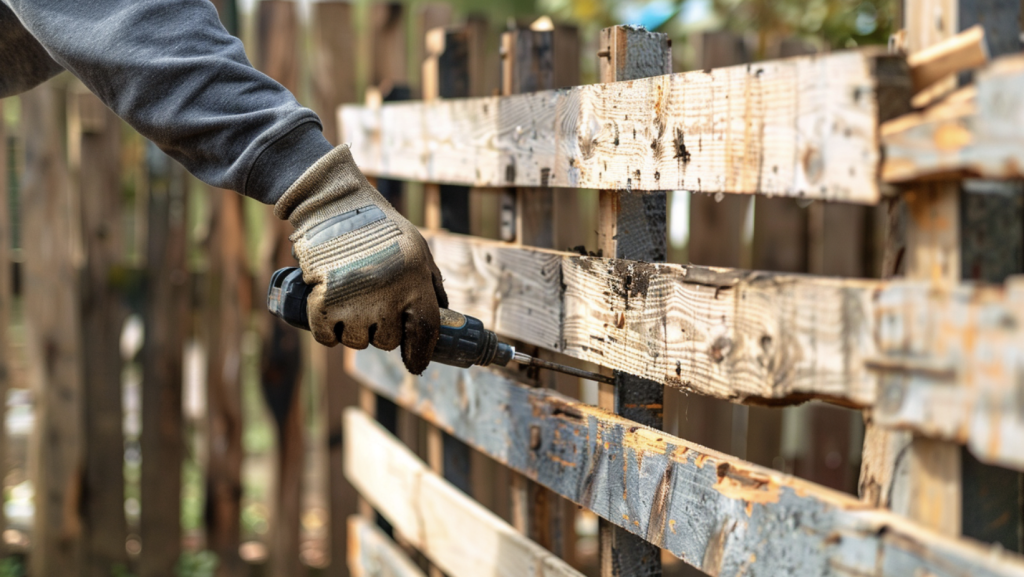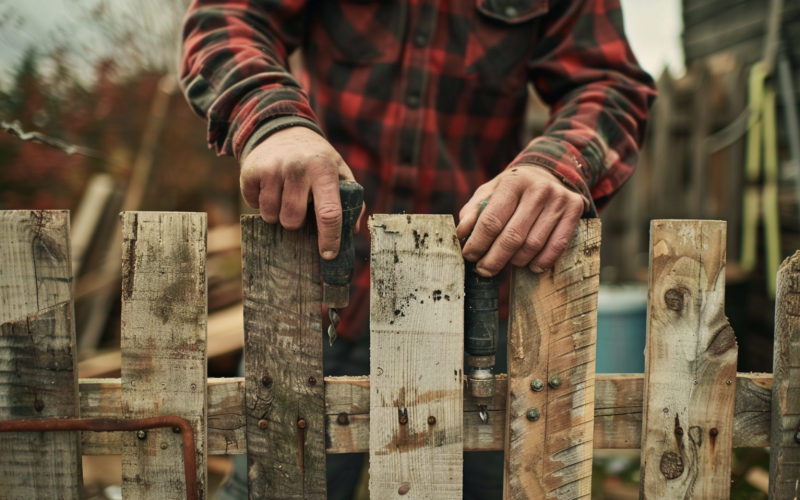A pallet fence might be the answer if you’re looking for a cost-effective and eco-friendly fencing solution.
However, ensuring its stability and longevity requires proper installation techniques. Don’t worry; securing a pallet fence is easier than you think!
In this article, we’ll guide you through building a sturdy pallet fence, from choosing the right materials to reinforcing it for added security.
Whether you’re seeking privacy and protection or simply exploring creative ideas for pallet fence designs, we’ve got you covered.
Following our expert tips and tricks, you can construct a durable and visually appealing pallet fence that will stand the test of time.
Let’s dive in and discover how to secure your pallet fence like a pro!
Preparing for Installation: Ground Preparation
Preparing the ground properly before you start building your pallet fence is crucial. A stable foundation ensures your fence will stand strong and last for years.
Clearing the Area
Remove any debris, vegetation, or obstacles in the area where you plan to install your fence.
This includes rocks, stumps, broken branches, and overgrown grass or weeds.
Use a rake or hoe to clear away smaller items and a shovel for larger objects.
Having a clean, unobstructed workspace will make the installation process much smoother.
Surface Smoothing
Once you’ve cleared the area, focus on creating a flat surface for your fence.
Remove any large stones or uneven clumps of dirt that could cause your fence posts to sit at different heights.
Use a level to check the ground’s evenness and add or remove soil as needed.
A flat surface will help ensure your pallet fence is straight and level.
Choosing the Right Foundation
Proper anchoring is crucial for ensuring the stability and longevity of your fence, especially when exposed to various weather conditions and external forces.
Concrete Foundations
Concrete is an ideal choice for permanent and highly stable pallet fence installations.
By setting your fence posts in concrete, you create a solid base that can withstand heavy winds, shifting soil, and other challenges.
Concrete foundations are particularly suitable for areas with extreme weather conditions or when a fence needs to last many years.
Metal Stakes
Metal stakes are a popular option for temporary or semi-permanent pallet fences.
They are relatively easy to install and can be removed without leaving significant damage to the ground.
Metal stakes work well for fences that may need to be relocated or when working with a limited budget.
Comparison: Concrete vs. Metal Stakes
When deciding between concrete foundations and metal stakes, consider longevity, cost, labor intensity, and suitability for your soil type.
Concrete offers unparalleled stability but requires more time, effort, and resources to install.
Metal stakes are more affordable and less labor-intensive but may not provide the same long-term durability as concrete, especially in loose or sandy soils.
Step-by-Step Installation: Different Foundations
By choosing the right foundation method and following these installation steps, you’ll ensure that your pallet fence is anchored securely into the ground, providing a stable and reliable structure for years to come.
1. Installing with Concrete
Materials Needed:
- Concrete mix
- Water
- Shovel
- Fence posts
- Mixing container
Mixing Concrete:
Follow the manufacturer’s instructions on the concrete mix packaging to ensure consistency.
Typically, dry concrete is mixed with water in a container until it reaches a smooth, pourable consistency.
Setting Posts in Concrete:
- Dig post holes approximately 1/3 the length of your fence posts and about twice the width of the posts.
- Place the posts into the holes, ensuring they are level and aligned with your fence line.
- Fill the holes with the mixed concrete, tamping it down to remove air pockets.
- Use a level to double-check the alignment of each post and make any necessary adjustments.
- Make the concrete cure per the manufacturer’s recommendations before attaching the pallets.
2. Using Metal Stakes
Materials Needed:
- Metal stakes
- Sledgehammer
- Level
Placement of Stakes:
Position the metal stakes inside the pallet fence line, ensuring they are evenly spaced and aligned with the pallets’ vertical supports.
The number of stakes needed will depend on the length of your fence and the weight of the pallets.
Securing Pallets to Stakes:
- Drive the metal stakes into the ground using a sledgehammer, leaving about 1/3 of each stake above the ground.
- Attach the pallets to the stakes securely using screws, nails, or wire ties. Make sure the connections are tight and can withstand movement.
- Check the level of the pallets as you attach them to the stakes, making adjustments as needed to maintain a straight fence line.
Choosing Fastening Materials for Joining Pallets

Screws
For outdoor durability, it’s best to use weather-resistant screws when connecting your pallets.
Screws provide a stronger hold compared to nails, especially in hardwoods where splitting can occur.
Look for coated or stainless steel screws that can resist rust and corrosion.
Nails
If you’re working with softer wood pallets where splitting isn’t a major concern, nails can be a suitable fastening option.
Choose nails long enough to penetrate the pallet boards and the frame for a secure hold.
Galvanized or coated nails are recommended for outdoor use to prevent rusting.
Adhesives
In high-stress areas or for added support, you can use construction adhesives in conjunction with screws or nails.
Apply a bead of adhesive along the edges where the pallets meet before fastening them together.
This extra step can help distribute the load and reduce the risk of the pallets separating over time.
Techniques for Securing Pallets Together
Aligning Pallets
Before connecting your pallets, lay them out in the desired configuration, whether in a straight line, staggered pattern, or at angles.
Use a tape measure to ensure consistent spacing between the pallets and check that each pallet is aligned horizontally and vertically.
This step is crucial for achieving a uniform and professional-looking fence.
Fastening Pallets Side-by-Side
- Position two pallets side-by-side, ensuring the edges of the pallet frames are flush against each other.
- Use clamps or have a helper hold the pallets to maintain alignment during fastening.
- Drive screws or nails through the pallet boards and into the adjacent pallet frame at regular intervals along the edge where the pallets meet. Space the fasteners evenly to distribute the load.
- Repeat the process for the remaining pallets in your fence line, checking for alignment and adjusting as needed.
Connecting Pallets End-to-End
- For extended fence lengths, you may need to connect pallets end-to-end. Start by positioning the pallets so that the ends of the frames overlap by at least a few inches.
- Secure the overlapping ends using screws or nails, driving them through the frame of one pallet and into the frame of the other.
- To enhance stability at the joints, consider attaching additional support beams across the connection point. Cut a length of 2×4 lumber to span the width of the pallets and screw it into place on both sides of the joint.
- Repeat the process for any remaining end-to-end connections, ensuring the pallets are level and aligned as you go.
Conclusion
Following this article’s step-by-step guide, you can create a sturdy, visually appealing fence that will last.
From selecting the right materials to reinforcing the structure for added durability, each stage of the process plays a vital role in the overall success of your project.
Remember to take your time, double-check your measurements, and don’t hesitate to seek help if needed.
With proper installation and maintenance, your pallet fence will provide a functional barrier and enhance the aesthetic appeal of your outdoor space.
So, grab your tools, gather your materials, and start building the pallet fence of your dreams today!











